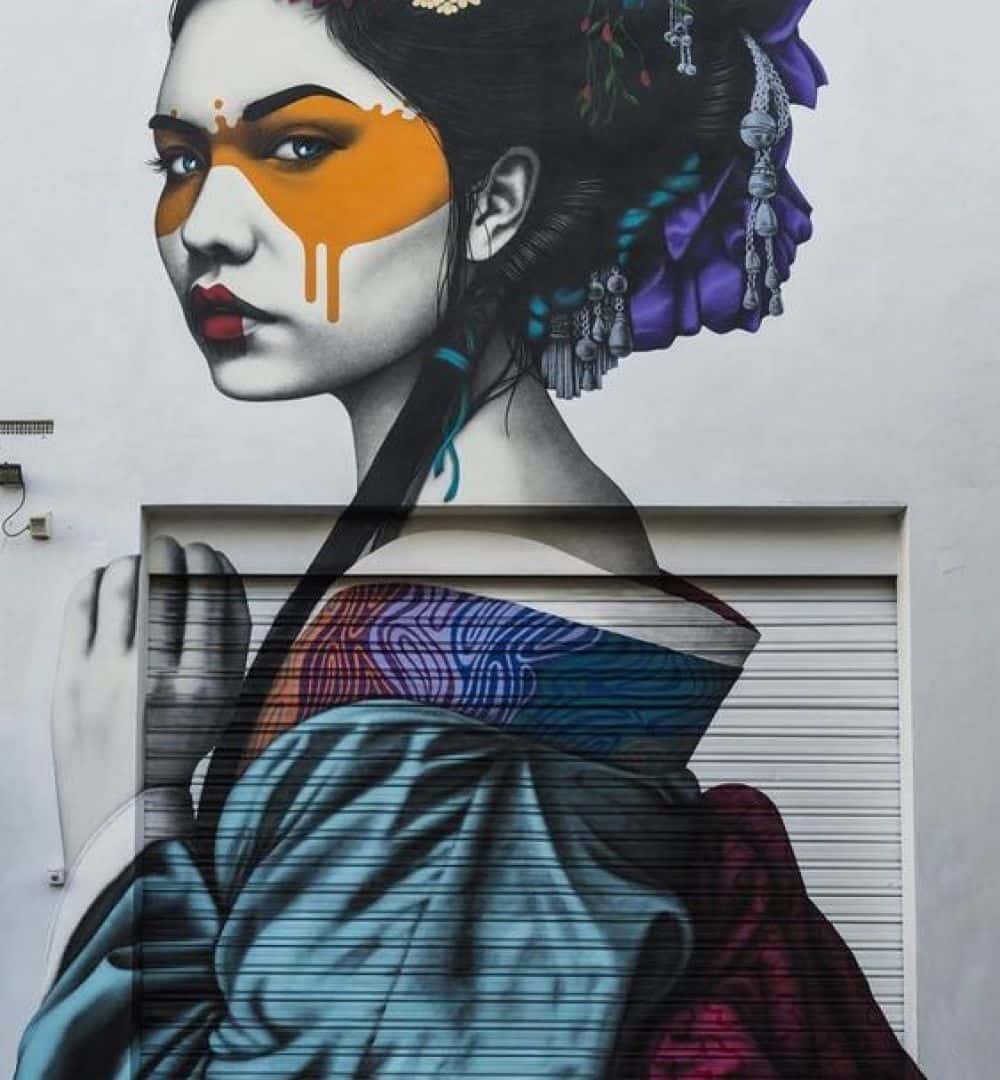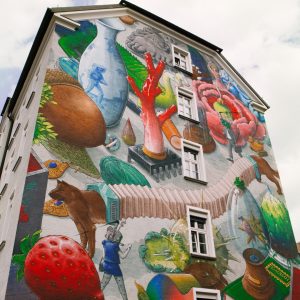Artist Maxime Drouet has recently worked on a new installation entitled “Vitrail” for 2022 UrbanArt Biennale in Völklinger Hütte. For the 30-meter installation, Drouet recreated scale 1 a wagon where he showcased all the windows and the doors that he painted on a train. All the windows are backlighted to recreate the unique ambiance like a cathedral with contemporary vandal stained glass.
Take a look below for an in-depth walk through and documentary on “Vitrail”
“Only in writing can I explain and try to make people understand the physical effort required to prepare a wagon the way I do. When I arrive in the train yard, I first have to find the model of train that I like, hope that it has all its windows and that it is not too far from the entrance.
The first step is to bring the equipment on site. For this project we are talking about more than 400 spray paint cans as well as everything you need to photograph, film and eat. A real base camp for the next 4 days.
Second step, I will repaint the wagon in black to have a neutral base and on which the colors will stand out. For the Völklinger Hütte installation, I knew that I was going to paint a black silhouette directly on the wall, hence the importance of this color for the transposition to be perfect. These are 6 hours of relentless painting, where every square centimeter is painted, from the wheels and sills, through the panels, to the top of the train more than three meters high and even the space in between the wagons. Only the windows are spared… for a good reason.
Third step, is to clean the windows (what we call “scraping”), for that I have to use a special stripper and a tool called a scraper. This step, which consists of scraping the paint from the windows to make them transparent again, is very physical, especially if there are several layers of paint. I had to scrape nearly 50 square meters for this project, the equivalent of half a tennis court. A full-day of work that will last until late during the night.
Fourth step, I can finally paint, a liberating moment where I can let go free my creativity and my emotions. Using transparent spray cans, and either using them in the traditional way with caps, or by piercing them, I can play on textures, color mixtures, to create abstract works where graffiti takes on a completely different meaning. Nevertheless, despite the experience of this painting process, there is still a part of randomness and when the glass does not please me I have to start it again so scrap it. It doesn’t matter how the train looks from the outside, what matters is what you see from inside the train, when the sun hits the window and reveals all the details. Thus transforming this abandoned metal and glass structure into a true contemporary cathedral. A whole day will be necessary to finally obtain the expected result.
Fifth and last step, the hardest part begins, I have to dismantle the windows and the doors. An operation to recover and preserve my work which must be done at night for more discretion. This part is a real ordeal, with accumulated fatigue, I now have to carry pieces of train, made of aluminum and Securit glass, for a weight per window of 30 to 40 kilos and each door panel of more than 50 kilos over several kilometers of rail road and ballast. Of course the pouring and freezing rain as well as a flood alert join the party, making the ordeal all the more difficult.
All this to say that this project is a real physical test, and that I hope people will better understand the difficulty of the installation presented at the UrbanArt Biennale in Völklinger Hütte and why it is impossible for me to do this more than once a year.”
“Now that the works are recovered it “only” remains to prepare everything for the exhibition. It starts with a month of work for two person to complete the installation of the LED panels for the backlighting of the windows. This allows me to artificially recreate sunlight, when there is some, and which allows me to reveal the colors and materials created during the painting. Exposed on the passenger side, the paint is thus preserved, and you can see the scratches left by the passengers on the original windows.
Direction Völklinger Hütte from Paris with more than 700 kilos of works, for 12 windows and three double doors. The realization of 3 years of preparation is finally approaching. Exhibiting in such a place, my work takes on all the more meaning by the close link that the site had with the rail roads. Like all iron and steel industries, it depended on it. Even today you can hear the freight passing from the showroom, the presence of rails on the ceiling reminds me of the railway tracks that I have been walking for years and which allow me today to present for the first time to the world, to my knowledge, such an exhibition.
It now remains to reproduce the silhouette of the train identically in order to be able to hang the windows on it. With the help of SNCF blueprints, and other measurements taken in the train yard, the painting is done to the exact cm. 23,30 meters long by 3,30 meters high for the main wagon, 30 meters long in all with the two wagons that surround it. The wheels, the panels, the chimneys, these details come to bring the final touch to the perfect reproduction of this typical French wagon of the 60s/70s.
All there is left is to hang the windows and doors and connect them to the current. The fateful moment is approaching. The light appears, and immediately the room atmosphere changes. The installation comes to life, the color schemes operate, the reflections on the ground give depth, for the first time I really see what I had imagined 3 years ago. The “experimental” sound made by DJ Pone that resonates perfectly completes the immersive experience. Produced from the sounds of trains, technical noises from the railway universe, noises of spray cans, this particular atmosphere will be familiar for an informed public, and for neophytes a perfect experience. A detail dear to my heart is hidden there, the sound I had recorded of the last journey of a “P’tit Gris de la Gare du Nord” before it was decommissioned. The end of an era for me, but here almost the beginning of a new one.
The video installations in addition allowing the spectator to understand all the journey to get there, I can say that the exhibition “Vitrail” for the UrbanArt Biennale 2022 is ready to receive its public. It took 5 days on site, and the help of a general manager, a painter, the person to document the installation and my partner for years, Gef, who developed the process with me of backlighting.
Why “Vitrail” (meaning stained glass) ? Because if obviously the installation refers in the first degree to a form of abstract contemporary stained glass, both visually and by the atmosphere of the room, it is also a testimony on my part. “Vitrail” is the assembly of the verb “Vit” (live) and the word “Rail”, because the rail is an important part of my life and a major component of it. This is my feeling, based on my experience over the past 20 years. Others will see it as the contraction of the words “Vitre” (window) and “Rail” recalling the very concept of the installation, or “Vite” (fast) and “Rail” referring more to the very essence of the graffiti of its constrained speed of execution by its still illegal character. Everyone is free to make their choice, all I can hope is that the public will understand the process and appreciate it. And will change their perspective on the most negative aspect of the graffiti, namely when you obstruct the traveler’s field of vision by painting on the train windows. Here it is not in a landscape that they will immerse themselves this time but in a universe of vibrant colors where everyone can see what they like.
About Maxime Drouet
In constant search of railway relics, Maxime Drouet provides the heritage of graffiti with tangible proof. It is much more than paint, train yards become cathedrals.
An insatiable wanderer, overwhelmed by the force of his own impulses, Maxime is brutally overtaken by the judiciary demons. In 2011, his favorite medium vanished with his freedom to paint, it was then a question of surviving his passion.
Photo credits: Maxime Drouet. Lukas Ratius for the photos during the installation





































comment